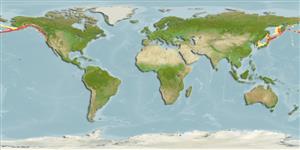>
Perciformes/Zoarcoidei (Eelpouts and pricklebacks) >
Lumpenidae (Eel pricklebacks)
Etymology: Lumpenella: Latin, lumpus, an uncouthlooking spiny-finned fish of a leaden-blue colour; diminutive (Ref. 45335).
More on authors: Evermann & Goldsborough.
Environment: milieu / climate zone / depth range / distribution range
Ecologia
marino demersale; distribuzione batimetrica 25 - 1140 m (Ref. 50550), usually 300 - 600 m (Ref. 51666). Temperate; 70°N - 33°N, 126°E - 121°W
North Pacific: Bering Sea and Aleutian Islands to British Columbia, Canada, Sea of Okhotsk, Pacific coast of northern Japan, Korean Peninsula and Sado Island in Japan Sea, and Greenland.
Size / Peso / Age
Maturity: Lm ? range ? - ? cm
Max length : 42.0 cm TL maschio/sesso non determinato; (Ref. 56527); peso massimo pubblicato: 150.00 g (Ref. 56527); Età massima riportata: 8 anni (Ref. 56557)
Spine dorsali (totale): 61 - 71; Raggi dorsali molli (totale): 0; Spine anali 3-5; Raggi anali molli: 36 - 42. Caudal rounded (Ref. 6885). Bluish brown on dorsal surface, silvery to sooty blue on ventral surface, sooty blue on cheeks, opercles, and gill membranes; fins dark (Ref. 6885).
Found offshore (Ref. 2850); possibly the deepest-living lumpenine (Ref. 51666).
Life cycle and mating behavior
Maturità | Riproduzione | Deposizione | Uova | Fecundity | Larve
Eschmeyer, W.N., E.S. Herald and H. Hammann, 1983. A field guide to Pacific coast fishes of North America. Boston (MA, USA): Houghton Mifflin Company. xii+336 p. (Ref. 2850)
IUCN Red List Status (Ref. 130435)
Threat to humans
Harmless
Human uses
Informazioni ulteriori
BibliografiaAcquacolturaProfilo di acquacolturaVarietàGeneticaElectrophoresesEreditarietàMalattieElaborazioneNutrientsMass conversion
CollaboratoriImmaginiStamps, Coins Misc.SuoniCiguateraVelocitàModalità di nuotoArea branchialeOtolithsCervelliVista
Strumenti
Special reports
Download XML
Fonti Internet
Estimates based on models
Preferred temperature (Ref.
123201): 0.8 - 4.8, mean 2 °C (based on 171 cells).
Phylogenetic diversity index (Ref.
82804): PD
50 = 1.0000 [Uniqueness, from 0.5 = low to 2.0 = high].
Bayesian length-weight: a=0.00355 (0.00148 - 0.00852), b=2.95 (2.74 - 3.16), in cm total length, based on LWR estimates for this (Sub)family-body shape (Ref.
93245).
Trophic level (Ref.
69278): 3.1 ±0.2 se; based on diet studies.
Resilienza (Ref.
120179): Medio, tempo minimo di raddoppiamento della popolazione 1.4 - 4.4 anni (Preliminary K or Fecundity.).
Fishing Vulnerability (Ref.
59153): Low to moderate vulnerability (32 of 100).
